In a previous article dating and identifying Griswold cast iron, we looked at different logos to determine the age of your Griswold iron cookware. And I gave a timeline of the small logo between 1939-1957. Still, Griswold introduced three design changes to the handle during this time. In this article, you will learn to identify these three handles to estimate the age of a small block skillet. I’ll also answer some common questions about the Griswold small logo block skillets.
Table of Contents
- Variations between molds and castings
- Early handle
- Middlemost handle design
- Grooved handle design
- Crossover dates
- The quality difference between handle designs
- Griswold small logo without ERIE PA marking
- Manufacturing dates and identification
Identify And Estimate The Date Of A Griswold Small Logo Skillet
To my knowledge, the following dates are close to the manufacturing dates. To get an idea of when Griswold used the small logo, Enthusiasts like myself look at catalogs, patent dates, resources, and expertise from other enthusiasts to piece together an estimate of the date of manufacture. So please use the following dates as an approximation.
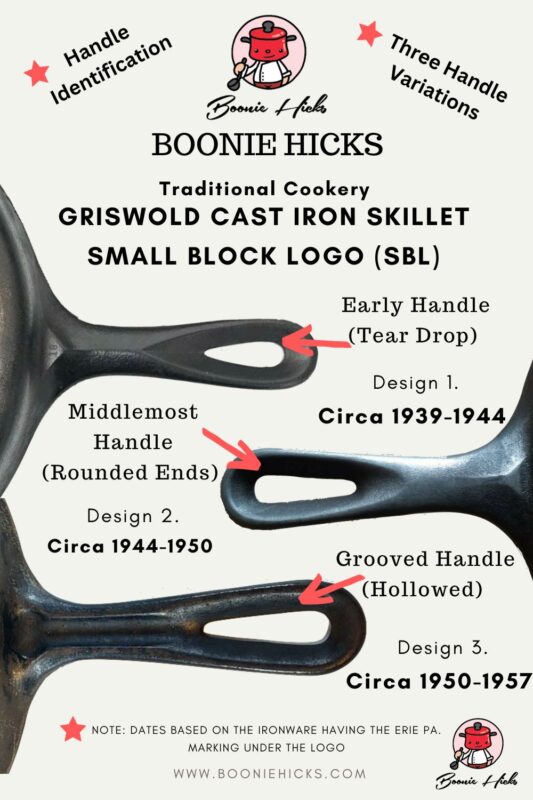
Why Do The Handles Look Different On My Griswold Small Block Logo?
Identification of the following three handle designs should be relatively easy. However, you can expect slight differences between each skillet due to the manufacturing and finishing techniques of the period.
As you can imagine, the foundry work of the 20th was more labor-intensive. Workers hand-shoveled sand into molds and packed the sand with a mallet to prevent air pockets and flaws in the casting. After pouring, the workers undoubtedly machined off any burrs, smoothed the handle, and rounded the edges on every pan.
Therefore, you can expect slight differences in the handle on every skillet, such as unevenness inside the handle hole. One handle may be flatter or more detailed than another. These differences can appear on skillets even with the same handle design.
Griswold Skillet with a small logo and an early handle. Circa 1939-1944
The handle design is also on skillets with large logos. It has a teardrop handle hole. The back has a slight ridge that tapers off into a triangular shape. The triangular reinforcement is an iconic Griswold design, and many collectors recognize a Griswold pan from this style handle.
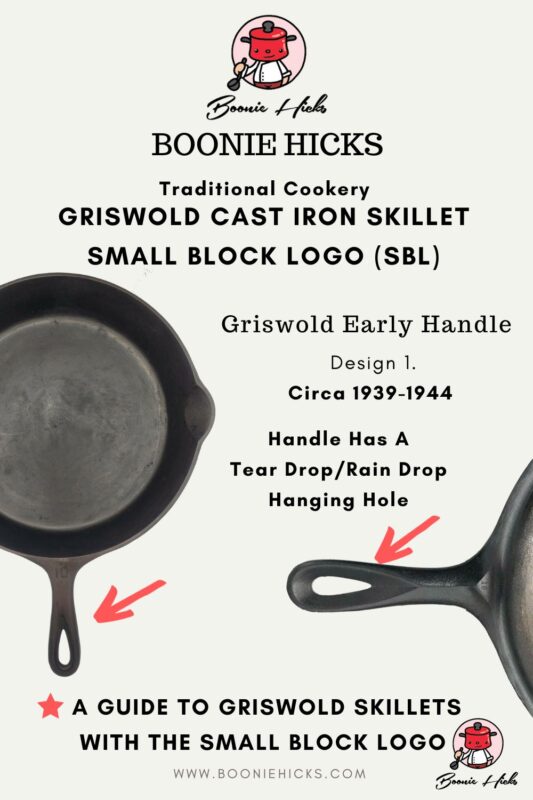
Griswold Skillets With Middlemost Design Circa 1944-1950
The handle hole takes on a rectangular design with curved edges. It is more modern looking than the classic teardrop shape. However, the handle still has the typical triangular reinforcement where the handle meets the pan.
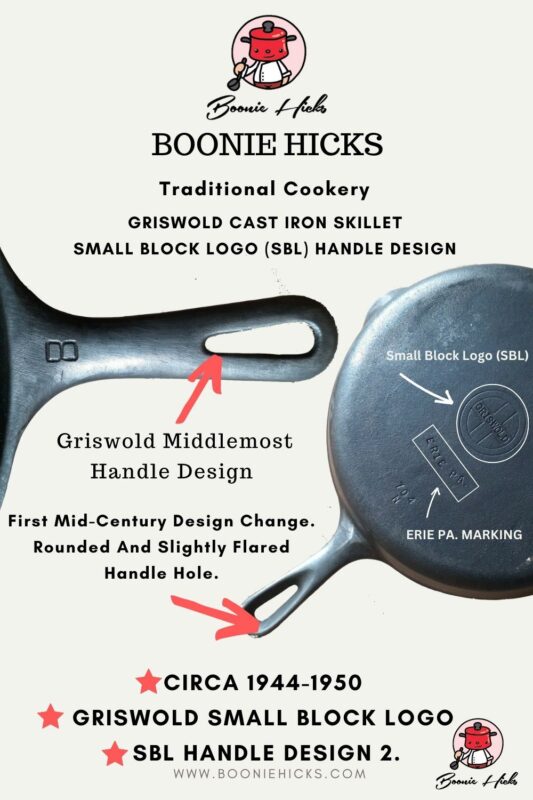
A Skillet With A Griswold Small Logo And Grooved Handle. Circa 1950-1957
The grooved handle is easily identifiable. While the curved rectangular handle hole remains, the back of the handle is grooved and lacks the typical Griswold triangular reinforcement.
I’m unaware as to why Griswold drastically changed the handle design. It could be a move towards customers embracing modern designs and competition from other cooking materials that forced Griswold to modernize the handle.
However, I think it was an effort to disperse heat away from the handle, making it easier to handle for consumers. Newly introduced cookware with plastic handles that never got hot in the mid-20th century undoubtedly took market share from traditional iron cookware makers.
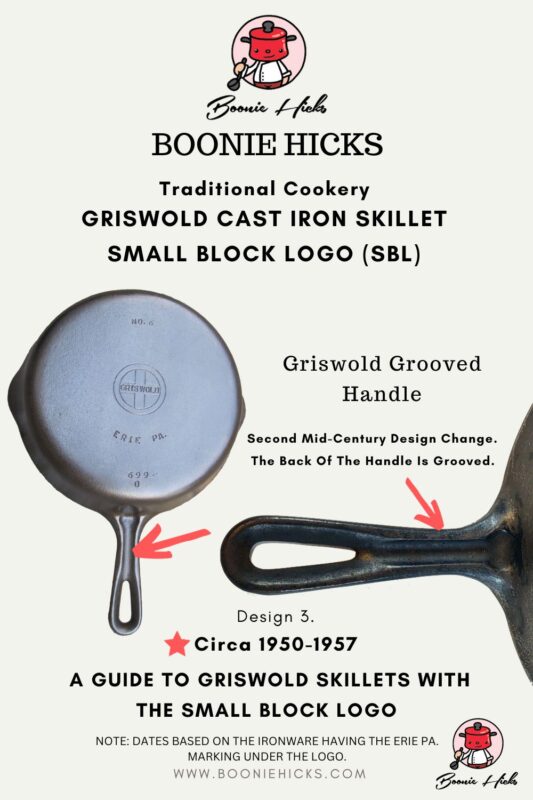
Did Griswold Make Multiple Different Designs At The Same Time?
I’m unsure if Griswold had a crossover time between each design of the small block logo. These dates are far from point-point accurate, but I hope it will still help owners and sellers identify and narrow the possible date of manufacture spanning nearly 20 years into three eras of Griswold handles.
Some factors that affect the manufacturing dates and purchasing of Griswold skillets with the SBL include:
- Griswold Manufacturing had molds on the premises to fulfill backorders requiring older designs.
- The unnecessary expense to melt and recast old stock in their supply stores for a slight change in the handle.
- The availability of older stock in stores.
- Tight financial pressure and iron shortages
Is One Handle Design More Collectible?
As far as I’m aware, collectors recognize the difference between the handle designs but do not consider one more desirable. The three handle designs fall into the Griswold Small Block category. When buying or selling, you should place more importance on the condition of the pan rather than the handle design.
Yet, I suspect some people focus their collection on one design over another. But I’d say this is a personal preference rather than collectability.
Are you deciding between a skillet with a small logo and a large logo? This article might help you choose a pan best suited to your needs.
Is There A Quality Difference Between The Griswold SBL Handle Designs?
Unless the skillet has undergone restoration, you can expect every vintage pan to have utensil marks and other abrasions from years of use. But I have seen no difference in quality between each handle design. Pans with early, late, and grooved handles should be equally smooth and finished to Griswold standards.
Some enthusiasts may argue the quality control standards slipped in later years. And I must admit I have noticed some rougher small logo pans. However, I do not know if this was due to poorer casting, pitting from acidic foods, or damp storage conditions. Undoubtedly, a rough cooking surface detracts from the collectibility and value of the pan but will likely have little to no impact on usability.
If you need some simple pointers on what to look for when purchasing a Griswold skillet, check out this article.
My Small Logo Skillet Does Not Have The Marking Erie PA.
If your skillet is missing, ERIE PA under the Griswold logo. It is a skillet using a Griswold mold, but production was not in the original Erie foundry. Many people assume Wagner made these skillets because Wagner Manufacturing bought the rights of Griswold in 1959. However, two other owners before Wagner may have produced this ironware.
These skillets are not as collectible but are great usable skillets that will cook just as well as any Griswold pan. And if you are thinking about buying your first Griswold pan, here is some advice for noncollectors.
Identification And Date Of Manufacture Of The Small Block Logo
By correctly identifying the type of handle on your skillet, you can narrow the date of a pan with a Griswold small block logo into three possible timelines. These dates are certainly not perfect, but they give you a close date of manufacture. Griswold skillets with a small logo are less desirable than large log pans. And this often reflects the value of the skillet.
However, these pans are still Griswold’s, and you’re lucky if you cook in one of these beauties. And I hope you enjoy using your Griswold small block skillet.
References
https://www.worthpoint.com/worthopedia/griswold-cast-iron-skillet-704-small-1896248466


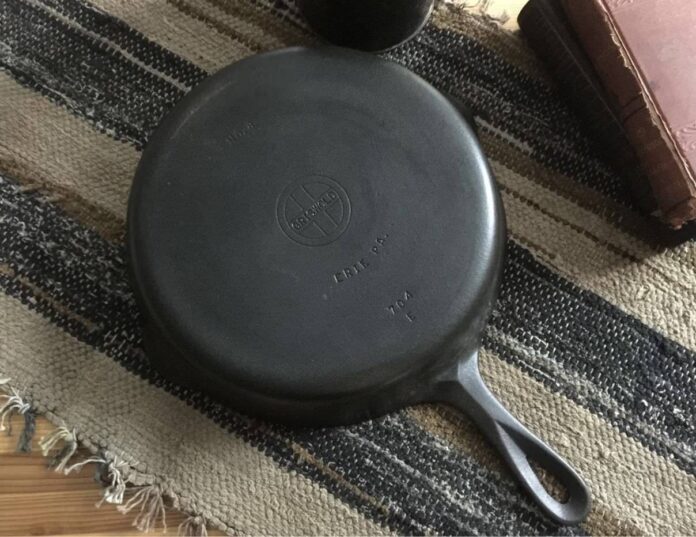
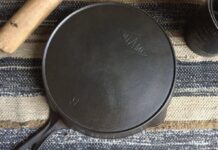
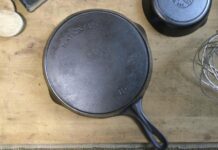
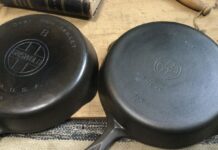



Hi there, I think a Griswold #12 is a small logo pan; it has “Erie” text but a fire ring. Did they make small logo pans with fire rings?
Hi Dave, thanks for getting in touch.
You are right. Your large #12 skillet will have a heat ring despite having a small logo. I’m unsure why Griswold kept the heat ring on the sizes numbers 12 and above, but they did. Great observation
I hope this helps.